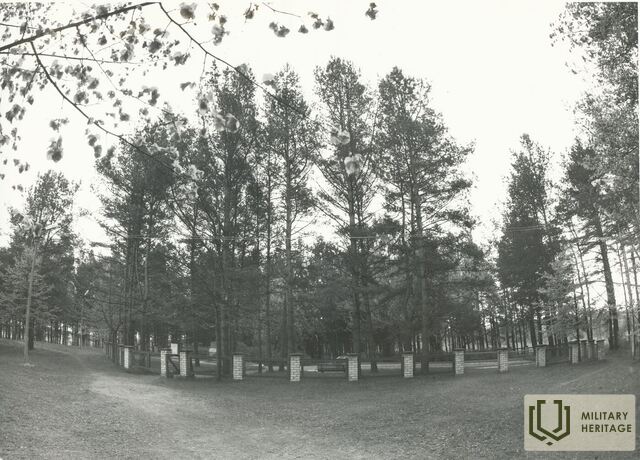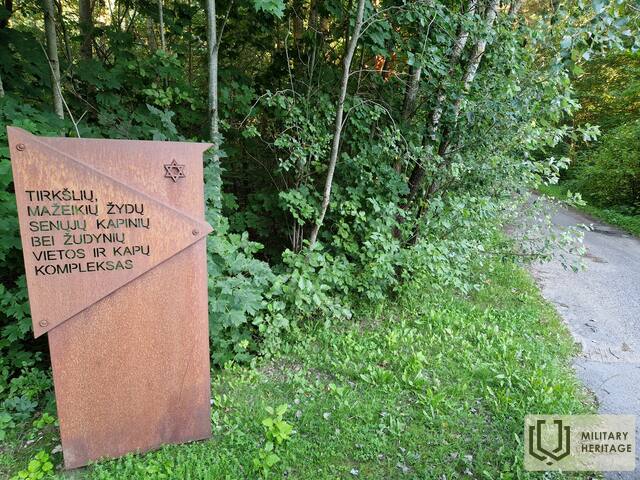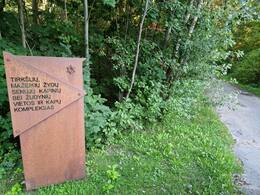2,500 unfortunate souls ended their lives in Mažeikiai

At the end of July 1941, a mass murder of Jews began in Mažeikiai, initiated by the Germans and later continued by local white-collar criminals. People were taken in groups to the Jewish cemetery, forced to undress, and shot near dug pits. Over the course of a few days, more than 2,000 Jews from Mažeikiai and surrounding towns were murdered.
"Rumors about the shooting of Jews in Mažeikiai spread at the end of July, when the Germans arrived in the city in three cars. On July 29, an eyewitness to the events, M. Noreikienė, saw how Jews who had been brought to the Jewish cemetery were digging holes, and the next day they were shot."
Participants in the events provide details: on the first day of the shooting, at approximately 6 a.m., the detainees began to be taken from the barn (about 200 m from the shooting site) in groups (40–50 people) to the Jewish cemetery. The guards, having opened the group, handed it over to the guards and went to drive others. They were taken to the pits in groups of 20–50 people. About 20 m before the pits, they were ordered to undress, sometimes even naked (this depended on gender and age). Those who were undressed were shot in groups (10 people), after which another group was brought. Food, vodka, and beer were brought to the cemetery for the executioners.
It is often stated that on the first day the Jews were shot by the Germans. On the following days the Germans were replaced by the Mažeikiai White Ribbon fighters. After the Mažeikiai Jews were shot, Jews from the towns of the county began to be driven into the barn. The barn could not accommodate everyone, so the others remained in the open air. The White Ribbon fighters guarded them, and in the first days of August they were shot in the same cemetery. The massacres lasted 3-4 days, and the White Ribbon fighters from the county villages also participated in them.
The number of Jews arrested and killed: Akmenė, Klykoliai and Mantartiškiai – about 70 people, Laižuva – about 40, Seda – about 300, Žemalė – 8–9 people, Tirkšliai – about 40, Vegeriai – about 30, Viekšniai – 400, Pikeliai – about 100, Židikai – about 300, Leckava – about 40, Mažeikiai – about 1,000.”
Related timeline
Related objects
Mažeikių ir jų apylinkių žydų žudynių vieta
Objektas yra prie senųjų Mažeikių žydų kapinių. Važiuojant Sedos gatve (164 keliu) iš Mažeikių link Tirkšlių/Sedos, kairėje kelio pusėje stovi ženklas „Žydų genocido ir II-ojo pasaulinio karo aukų kapavietė“.
Iki Holokausto pradžios, 1940 m. liepos 1 d., Mažeikių mieste gyveno apie 1 100 žydų. 1941 m. birželio pabaigoje, prasidėjus vokiečių okupacijai, iki 1 000 žydų buvo suimti ir laikomi Mažeikių sinagogoje. Liepos viduryje Leckavos žydai – apie 40 žmonių – buvo uždaryti į Lačo daržinę Mažeikiuose, moterys ir vaikai – daržinėje, o vyrai – sinagogoje.
1941 m. liepos 29 d. į Mažeikius atvykę vokiečiai vertė žydus kasti duobes prie žydų kapinių, o liepos 30 d. 6 val. ryto prasidėjo masinės žudynės. Pirmą dieną šaudė vokiečiai, vėliau žudynes tęsė vietos baltaraiščiai. Rugpjūčio pradžioje prie tų pačių kapinių sušaudyti ir žydai iš kitų valsčių bei tarybiniai aktyvistai.
1944 m. gruodžio 7 d. sovietų komisijos nurodymu buvo atkasti kapai ir atlikta teismo medicininė ekspertizė. Konstatuota, kad už 3 km nuo Mažeikių, ant Ventos upės kranto, žydų kapinėse rastos 5 kapavietės, kuriose užkasta apie 4000 palaikų. Prie Mažeikių sušaudytų žydų skaičius nurodomas skirtingai – nuo 3000 iki 4000. Istoriniai tyrimai leidžia teigti, kad šie skaičiai padidinti – aukų būta apie 2500.
Šiuo metu objektas yra lankytina vieta, kurią gali aplankyti visi besidomintys karinio paveldo istorija.






